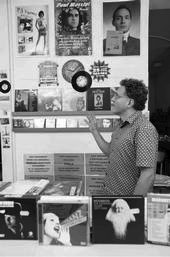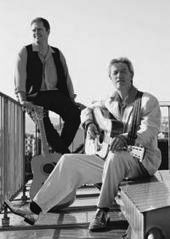Salmon
in a Ring-Shaped River
Veit
Stauffer of Zurich, Switzerland could easily lay claim to
the title of Tim Buckley Überfan.
Below
are the sleeve notes that accompanied Comebuckley - Salmon
In a Ring-shaped River, a double-CD, released as ReCDec
83 on September 28th, 2007.
He
runs the independent record shop Rec
Rec in his hometown.

Veit
Stauffer at the Rec Rec |
He
coached the tribute band Comebuckley of Zurich, immersed
himself in an unfinished movie-project on Tim Buckley, had
an intense letter exchange with Buckley’s guitarist
Lee Underwood, visited his widow Judy in Los Angeles and
almost met his son Jeff twice.
Veit
could have strayed every second line for yet another anecdote.
We asked him to bundle his archeological results of a passion
that hasbeen lasting for three decades…
Andi
Czech
From
City Vibes via Comebuckley to Radio Osaka
Helvetia
was the first City Vibes song I heard in February 1979 in
the cellar at the Weinbergstrasse 84 in Zurich when
I was auditioning as their first drummer. They had already
worked out four songs and were (as it then was fashionable)
keen on releasing a single EP as soon as possible.
“Helvetia....Helve-tii-aa...”
were the words whispered by 22-year-old singer Andi Czech
into the microphone during the clever intro, and the timbre
of his voice instantly reminded me of Tim Buckley, a singer
I had discovered in June 1977. My admiration for Buckley’s
music had grown and sent me off on an eighteen-month odyssey
to find the nine albums that he had recorded between 1966
and 1974.
However,
I pushed that thought aside, because at the time we were
into bands like Wire, Talking Heads, Television, Patti Smith
and Pere Ubu. A schoolmate of Andi’s had just emigrated
to London and also had a very high opinion of Tim Buckley.
His
name was Hanspeter “Düsi” Künzler, still
to this day the most important Swiss music journalist living
outside of Switzerland. In the spring of 1980, Andi began
showing more interest in Buckley’s music and I lent
him my treasured albums to copy. I also gave him a songbooks
published by the French music magazine Atem in May
1977 which contained most of his lyrics.
In
the summer of 1985, the City Vibes rejoined for a short
comeback. There were ten rehearsals and interesting ideas,
but in the end, the project failed. I proposed a Tim Buckley
cover version and chose 1972’s Get on Top, perhaps
the initial spark for all further Tim Buckley projects...
In
the autumn of 1986, I received an invitation from Czech
for the only performance of the party band Bye Bye Brothers
at Der Kanzlei in Zurich. They performed various
cover versions from the 60’s and 70’s, as well
as three Tim Buckley tracks: No Man Can Find The War,
Stone in Love and Quicksand. I was delighted
and stunned.
In
a surge of euphoria after the concert, I told Andi that
I would produce a tribute album for Tim Buckley, whenever
he liked to. This was a remarkable proposal for two reasons:
firstly, tribute albums were practically unknown back in
1986, and secondly, I knew next to nothing about producing.
Andi’s
fellow student Urs Rageth, was engaged as co-producer. Guitarist
Jürg Breitschmid brought along his experience as a
sound engineer. Soon the four of us met and we all made
a list of our favorite tracks. The songs that appeared on
all four lists made it to the final round. Andi became totally
involved with this ambitious project, and until today, it
is his specialty to sing and act like Tim Buckley, with
awe but also like a rogue.
|
"Timing
was perfect when Paul Fischli gave me a video that
he had found in Claude Nobs’ Montreux Jazz Festival
Archives. It was there that for the first time I saw
Tim Buckley in action.
I was emotionally overwhelmed..."
|
In
Spring 1987 things got really serious. On one weekend, the
Tim Buckley Band (Andi Czech, Jürg Breitschmid, Urs
Klingler, Phil Esposito, Fredi Flückiger and Tommi
Meier) locked themselves up in a vacation house in Frutigen,
Berne, for the final and intense rehearsal sessions with
co-producer Urs Rageth.
I
was in the midst of a painful separation; it looked like
that my two-year old son Orlando would spend his childhood
in the distant city of Amsterdam, ten hours away from me.
I tried to cope rationally with the situation but I was
suffering from huge mood swings, lovesickness and jealousy,
anger and desperation, accusation and conciliation. I was
28 and had just bought my first bottle of cognac so that
I could take a calming sip from time to time. On Sunday,
I arrived in Frutigen to listen to the results on tape.
If
I think back about this today I can’t help but smile.
Like a 'real manager', I theatrically covered my face with
my hands and shouted “No way!“ Some of the songs
were falling apart and I missed a sense of commitment and
determination. I tried to articulate my doubts as objectively
as possible; in any case they soon started to show an effect.
Andi
took over responsibility for the musical concept, and we
also had a joker up our sleeve called Ben Jeger, a famous
keyboard player from Solothurn, who was supposed to come
directly to the Sunrise studio in Kirchberg SG with his
accordion and Hammond organ.
Witnessing
the three days in the studio with soundman Hairi Vogel turned
out to be a fascinating experience. The atmosphere was frisky,
but we were very concentrated. We had chosen six songs from
the years 1967-1972 and each song needed its own setting.
Side A should show the rock-driven, extroverted side of
Buckley, Make it Right was the short concentrate
of Sweet Surrender, one of Buckley’s most accomplished
songs, especially the string arrangement.
Comebuckley
managed to approach the song with a confident post-punk
attitude, and while Ben Jeger graced the song with his Hammond,
Czech conjured up the sexual despair of the protagonist
with in a totally credible way.
No
Man Can Find The War was also brilliant, featuring formidable
teamwork: Breitschmid has great some moments on screaming
lead guitar, the whole rhythm-section is perfectly interlocked
and Czech performs an ingenious trick with a double-superposed-echo
scream, all culminating in the sound of a huge bomb explosion
at the end of the track.
The
arrangement of Pleasant Street was highly effective:
discreet and sparse, with elegant piano playing in the beginning
it slowly builds up to an explosive refrain.
Side
B is dedicated to the introverted and experimental night-side
of Buckley. Hymnic and ghostly, The River continues
to produce goose bumps: a hypnotic sound-carpet with desolate
guitar licks and the marvelous Fredi Flükiger on percussion
with dampened drums.
Then
the greatest challenge - a piece from 1970’s Starsailor.
Jungle Fire is one single ritual séance, beginning
with a moderate intro with sampled whale sounds, then 160
seconds later, the outburst and entrance of tenor saxophonist
Tommi Meier, a creative chaos: “Mama Lion, I love you
like a jungle fire” - which leads to a wonderful, totally
original contribution of the Comebuckley Crew.
A
quote from Buckley - “Everything is Music“ - had
been expanded and translated to Italian: Tutto e musica-continuere
a vivere-finche tu amerai-la mia musica. The four singers
of the female a capella band Sophisticats - Clara
Buntin, Eva Enderlin, Yvonne Geraedts and Erika Stucky -
were invited to improvise on these words during a special
recording session in the woods at the Uetliberg, close to
Zurich:
Since
there already was a New York garage band with the same name,
the group later changed their name to Sophisticrats and
released two albums Four Singers and Bass in 1990
and We Love You two years later. Afterwards, Erika
Stucky began a successful solo career as a jazz singer.
The
final song was the beautiful Blue Melody, featuring
the lead guitar of Breitschmid and Ben Jeger on accordion.
The
following week I listened nonstop to the rough mix. The
astonishing result of thirty minutes saved my inner life
in the early summer of 1987.
I
had been in contact with Tim Buckley guitarist and journalist
Lee Underwood since November 1985. His reaction was euphoric
and encouraging.
“I
am impressed with your dedication to Tim and his music,
as well as how closely the singer resembles Tim’s tone
and nuance. Obviously, a lot of work went into studying
Tim, working out the arrangements, recording etc. I think
you guys are terrific, and, indeed, I wish you all the best
of success!”
On
one hand, we had huge expenses to meet in order to mix the
songs at the Powerplay studio, while on the other hand the
preparations for the album release party on the fifth of
December 1987 at the nightclub Rote Fabrik were at
full speed. Comebuckley was scheduled for a big party for
1500 people.
Timing was perfect when then-WEA employee Paul Fischli gave
me a video that he had found in Claude Nobs’ Montreux
Jazz Festival Archives. It was there that for the first
time I saw Tim Buckley in action, singing two tracks; Dolphins
and Honey Man, recorded in May 1974 with crack British
studio players Tim Hinkley, Ian Wallace and Charlie Whitney.
I was emotionally overwhelmed.

Comebuckley
Light
Sturzenegger and Czech |
In
February 1989, we had the chance to go on stage again. The
studio band of 1987 was no longer available, so Fish of
Hope, the band of Basel songwriter Sky Bird, filled the
gap. This time we chose seven different Buckley songs that
we arranged in our usual fashion: Sally Go Round the
Roses, Honey Man, Mexicali Voodoo, Song to The Siren, Sefronia,
Stone In Love and Dolphins.
In
1992 Andi Czech began his newest project Radio Osaka, an
amalgam of experimental rock, jazz, electronica and ambient.
This band included Tommi Meier and Fredi Flükiger of
Comebuckley and from 1993 until 2004, recorded seven CDs,
including two remix CDs and a live CD. A new addition was
guitarist Stephan Thelen, a pupil of Robert Fripp and an
important figure for the 2007 production.
In
2003, Czech initiated the duo project Comebuckley Light.
First, he covered Buckley songs as solo unplugged versions,
but soon asked his friend Martin Sturzenegger to join him.
The songs had been sung by Andi at home over the years,
and were now expanded to fit the new duo.
Martin
(in 1982 a member of the punk band K.O.K. and for years
a member of the Neil Young cover band Young) convinces with
his earthy rhythm guitar as well as with effective backup
vocals. This smaller Comebuckley formation takes the initial
concept a few steps further; sticking very closely to the
original versions, while revealing unexpected qualities
of the material.
In
this context, a minor mystery was recently unraveled and
Buckley managed to surprise me again. I thought that Sally
Go Round The Roses was a cover version of the 1963 hit of
the female black band The Jaynettes. In the 1974 UK version
of Sefronia, Lona Stevens and Zell Sanders are listed
to be the authors, while all other versions declare Tim
Buckley to be the author and the publisher seems to be indecisive).
The truth is that Buckley only kept the refrain, wrote his
own lyrics and conjured a completely different tune…
Personally,
I would loved to have given Comebuckley Light two songs
of Fred Neil and two of Jeff Buckley, and then send the
duo (which performs in Switzerland on a regular basis) on
tour abroad: this in accord with my ironically meant motto,
created at a 1979/80 New Years Eve party for the City Vibes,
“I will take you to America!“